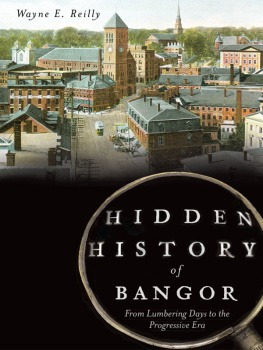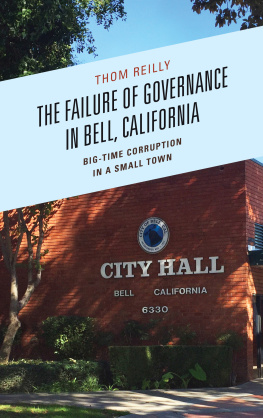Reilly - Hidden History of Bangor: From Lumbering Days to the Progressive Era
Here you can read online Reilly - Hidden History of Bangor: From Lumbering Days to the Progressive Era full text of the book (entire story) in english for free. Download pdf and epub, get meaning, cover and reviews about this ebook. year: 2013, publisher: Arcadia Publishing Inc., genre: Non-fiction. Description of the work, (preface) as well as reviews are available. Best literature library LitArk.com created for fans of good reading and offers a wide selection of genres:
Romance novel
Science fiction
Adventure
Detective
Science
History
Home and family
Prose
Art
Politics
Computer
Non-fiction
Religion
Business
Children
Humor
Choose a favorite category and find really read worthwhile books. Enjoy immersion in the world of imagination, feel the emotions of the characters or learn something new for yourself, make an fascinating discovery.
- Book:Hidden History of Bangor: From Lumbering Days to the Progressive Era
- Author:
- Publisher:Arcadia Publishing Inc.
- Genre:
- Year:2013
- Rating:5 / 5
- Favourites:Add to favourites
- Your mark:
- 100
- 1
- 2
- 3
- 4
- 5
Hidden History of Bangor: From Lumbering Days to the Progressive Era: summary, description and annotation
We offer to read an annotation, description, summary or preface (depends on what the author of the book "Hidden History of Bangor: From Lumbering Days to the Progressive Era" wrote himself). If you haven't found the necessary information about the book — write in the comments, we will try to find it.
Reilly: author's other books
Who wrote Hidden History of Bangor: From Lumbering Days to the Progressive Era? Find out the surname, the name of the author of the book and a list of all author's works by series.
Hidden History of Bangor: From Lumbering Days to the Progressive Era — read online for free the complete book (whole text) full work
Below is the text of the book, divided by pages. System saving the place of the last page read, allows you to conveniently read the book "Hidden History of Bangor: From Lumbering Days to the Progressive Era" online for free, without having to search again every time where you left off. Put a bookmark, and you can go to the page where you finished reading at any time.
Font size:
Interval:
Bookmark:



Published by The History Press
Charleston, SC 29403
www.historypress.net
Copyright 2013 by Wayne E. Reilly
All rights reserved
Front cover: Downtown Bangor before the fire of 1911. Courtesy of Richard R. Shaw.
First published 2013
e-book edition 2013
Manufactured in the United States
ISBN 978.1.62584.088.2
Library of Congress Cataloging-in-Publication Data
Reilly, Wayne E., 1945
Hidden history of Bangor : from lumbering days to the progressive era / Wayne Reilly.
pages cm. -- (Hidden history)
Includes bibliographical references.
Summary: Forgotten stories and moments from Bangors past--Provided by publisher.
print edition ISBN 978-1-62619-010-8 (pbk.)
1. Bangor (Me.)--History--Anecdotes. 2. Bangor (Me.)--Social life and customs--Anecdotes. 3. Bangor (Me.)--Biography--Anecdotes. I. Title.
F29.B2R455 2013
974.13--dc23
2013021769
Notice: The information in this book is true and complete to the best of our knowledge. It is offered without guarantee on the part of the author or The History Press. The author and The History Press disclaim all liability in connection with the use of this book.
All rights reserved. No part of this book may be reproduced or transmitted in any form whatsoever without prior written permission from the publisher except in the case of brief quotations embodied in critical articles and reviews.
To Madeleine, Benjamin, Alexander, Nora and Amelia
CONTENTS
INTRODUCTION
When celebrity aviator Harry Atwood made the first airplane flight over Bangor on June 17, 1912, local observers were ecstatic. Over the past few decades, they had witnessed men take to the air in balloons and dirigibles, but they had never seen a heavier-than-air craft get off the ground more than a few feet. Atwoods performances signaled the future. Flight would shorten the distance between the city, which seemed increasingly isolated far up on the Penobscot River near the very northeastern tip of the United States, and the major population centers along the East Coast and Out West, where so many had moved in the past few decades. Optimists predicted Bangor would one day live up to its regal nickname, the Queen City of the East.
The local merchants who had sponsored Atwoods appearance wanted to let the rest of New England know that Bangor was back in business after the disastrous fire that had destroyed much of the downtown less than a year before. New buildings were going up, bigger and taller than the buildings that had burned. The city would soon have a new post office, high school, library and several churches, as well as hotels and office buildings. In the meantime, dozens of shack stores lined a few streets, as merchants attempted to get back on their feet.
Bangor was no longer known as the lumber capital of the world. That honor had headed west along with many of the states residents in the last few decades in search of more economic opportunities. Thats why today you can see giant statues of Paul Bunyan from Bangor to California. Indeed, long before the great fire of 1911, the Queen Citys busy harbor and lumber mills, its ice industry and shipbuilding business had all gone into decline. Efforts to open large textile mills and shoe factories had failed. Keen eyes had noticed, however, the growth of towns and small cities to the north and east thanks to the coming of the Bangor and Aroostook Railroad and the growth of the potato business and the paper industry. People in these hinterlands had always looked to Bangor for supplies. As these rural towns grew bigger, Bangor found itself evolving into the shopping center for the upper two-thirds of the state of Maine, stretching north, east and west away to the Canadian border, a place where people came for health care, advanced education and financial transactions, as well as groceries and hardware.
The historical essays in this book, my second volume of newspaper columns published by The History Press, focus on the part of this transitional period that lasted a little more than a decade, roughly between the time the first automobile chugged into town in 1900 to daredevil Harry Atwoods flying stunts. Vaudeville and the movies were taking over the theaters. The electric light bulb was still a wonder to behold, while the wireless promised a new world of communication. The train was the only way out of town in the winter when the harbor was frozen, and the Boston boats stayed out at sea.
Bangor was still wide open despite the fact that Maine had instituted the first-in-the-nation state prohibition law more than fifty years before. Lawmen half-heartedly battled the citys numerous saloons and brothels on an almost daily basis. This army of vice included Aunt Hat, the areas most notorious madam, who catered to the thousands of itinerant loggers and other workers who passed through the Queen City annually on their way to and from the North Woods.
At the same time, Progressive Era activists, a Christian army of ministers, professors, businessmen and clubwomen, sought to overhaul society. Reforms including night schools, playgrounds and childrens clubs like the Boy Scouts were intended to help the poor, including the thousands of immigrants who had come to the city in search of work and a place to live. Nearly 40 percent of Bangors population in 1910 consisted of immigrants or the offspring of immigrants from as far away as Russia and China. Even Carry Nation, one of the nations most famous reformers, joined the fray, anointing the Queen City of the East with one more nameRotten Bangor!
This book is divided into seven sections ranging in subject matter from technological triumphs to the fire of 1911 to Maines first-in-the-nation prohibition law. Each section contains a half dozen or so of my columns published in the Bangor Daily News between 2003 and 2013. Each bears the original date of publication to make it clear what is meant in the text by a century ago.
Back then, the city had two daily newspapers: the Bangor Daily News, which catered to Republican readers, and the Bangor Daily Commercial, a paper appealing to Democrats. I have spent ten years reading these newspapers week by week on microfilm searching for stories worth retelling. Most columns are based on months of newspaper stories as well as research in other sources, which are listed in the columns as well as in the bibliography at the end of this book.
Over the years, I have received a great deal of assistance from various individuals. I am especially obliged to Richard R. Shaw, whose books of historic Bangor photographs have done much to preserve the history of the city. Dick has been generous with information based on his extraordinary knowledge of his hometown. He has also provided me with most of the photographs and other images for my columns both in the newspaper and in my books.
Others who have been helpful include Bill Cook and Elizabeth Stevens in the Bangor Public Librarys Local History Room, as well as several other librarians on the reference staff; Dana Lippitt at the Bangor Museum and History Center; the staffs in Special Collections at the University of Maines Fogler Library and the microfilm reader room; Kevin Johnson at the Penobscot Marine Museum; and Jamie Kingman-Rice at the Maine Historical Society. A few other individuals and organizations are credited in specific columns. Special thanks as well go to the editorial staff at the
Next pageFont size:
Interval:
Bookmark:
Similar books «Hidden History of Bangor: From Lumbering Days to the Progressive Era»
Look at similar books to Hidden History of Bangor: From Lumbering Days to the Progressive Era. We have selected literature similar in name and meaning in the hope of providing readers with more options to find new, interesting, not yet read works.
Discussion, reviews of the book Hidden History of Bangor: From Lumbering Days to the Progressive Era and just readers' own opinions. Leave your comments, write what you think about the work, its meaning or the main characters. Specify what exactly you liked and what you didn't like, and why you think so.

















